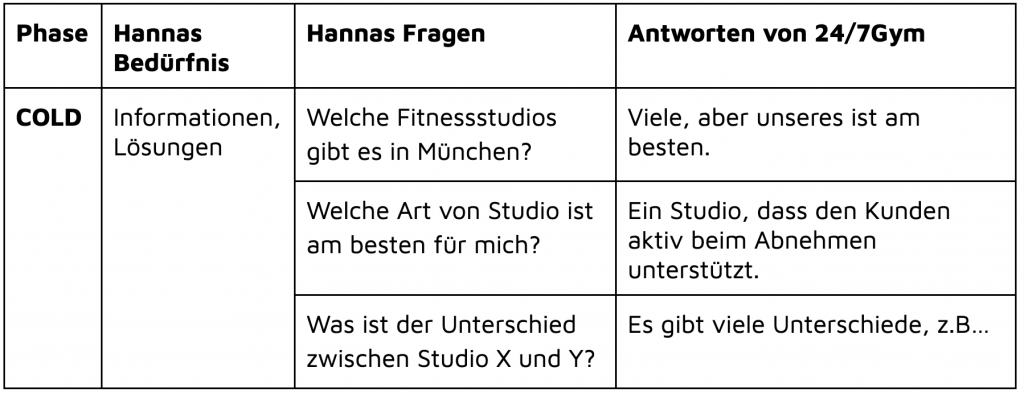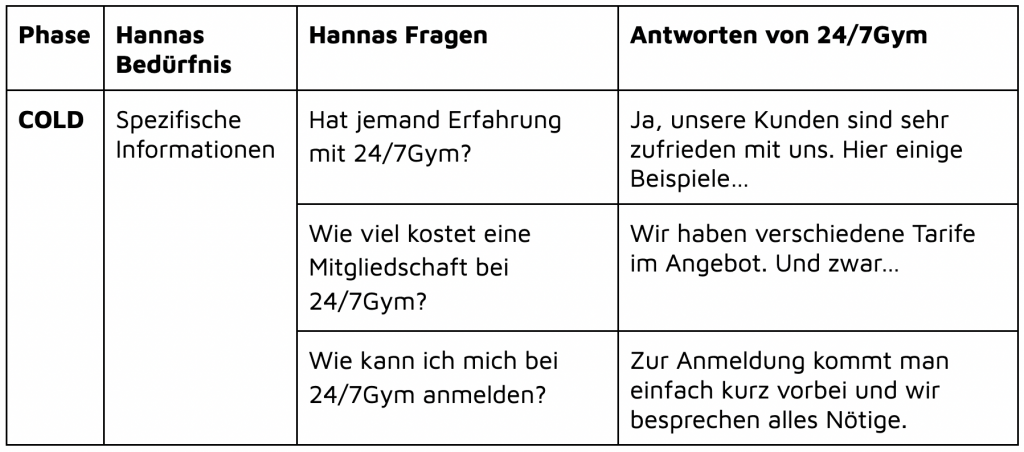Warum du für deine Content Marketing Strategie nur 3 Customer Journey Phasen benötigst
Für eine erfolgreiche Content Marketing Strategie ist das Beschäftigen mit den Customer Journey Phasen ratsam. Im folgenden Blogartikel möchten wir alle wichtigen Informationen zur Customer Journey zusammenfassen. Außerdem zeigen wir an einem konkreten Beispiel, wie einfach die drei Customer Journey Phasen der Content Marketing Agentur COCO anzuwenden sind.
Was bedeutet die Customer Journey für deine Content Marketing Strategie?
Übersetzt steht Customer Journey für die “Reise des Kunden”. Sie ist ein Instrument der Content Marketing Strategie. Denn sie beschreibt die Summe aller Kontaktpunkte zwischen Unternehmen und (potenziellen) Kunden.
Häufig ist es ein langer Prozess, bis eine Person sich für ein Produkt oder eine Dienstleistung entscheidet. Vom ersten Kontakt mit einem Unternehmen bis zum Kauf kann viel Zeit vergehen. Es stehen zahlreiche Marketingmaßnahmen dazwischen. Dieser Prozess kann für mehr Übersichtlichkeit in die Customer Journey Phasen unterteilt werden.
Kurz gesagt beschreibt die Customer Journey die “Reise” des Nutzers vom Interesse, über den Kauf bis zur Nachkaufphase. Das Ziel der Online Marketing Strategie ist es, die Bedürfnisse des Kunden über alle Customer Journey Phasen zu erfüllen.
Hierzu zählen ausdrücklich nicht nur die Promotion eines Produktes vor dem Kauf. Auch die Erfahrung während des Kaufs sowie die Kundenbindung nach einer Transaktion sind relevant. So wird sichergestellt, dass Kunden dem Unternehmen treu bleiben. Außerdem sollen sie bei erneutem Bedarf nicht den Anbieter wechseln.
Für eine erfolgreiche Content Marketing Strategie müssen die Inhalte der Website auf die Bedürfnisse des Kunden abgestimmt werden. Diese Bedürfnisse unterscheiden sich je nach Customer Journey Phasen.
Häufig wird das Modell der Customer Journey Phasen ähnlich wie ein Fahrplan dargestellt, den der Kunde durchläuft. Dieser Fahrplan besteht aus unterschiedlichen Touchpoints.
Was sind die Customer Journey Phasen?
Die Customer Journey Phasen sind je nach Modell unterschiedlich definiert. Häufig wird zwischen fünf und sieben Phasen unterschieden. Einige Beispiele für Customer Journey Phasen sind im Folgenden dargestellt.
Auf die Touchpoints der einzelnen Abschnitte soll anschließend eingegangen werden.
Einfaches Modell für Customer Journey Phasen
- Vorkaufphase
- Kaufphase
- Nachkaufphase
Bei diesem Modell wird unterschieden, in welcher Phase des Kaufprozesses der Kunde welche Bedürfnisse hat. Bevor der Kunde das Produkt kauft, hat er häufig über unterschiedliche Kanäle Kontakt zum Unternehmen.
In der Kaufphase ist der Schnittpunkt häufig der Onlineshop oder die Website. In der Nachkaufphase wird der Kontakt über Newsletter, Social Media oder Telefonsupport aufrechterhalten.
Diese drei Customer Journey Phasen stellen die Reise des Kunden vom Erstkontakt bis zur Pflege der Kundenbeziehung dar.
Umfassendes Modell für Customer Journey Phasen
- Awareness (Bewusstsein)
- Consideration (Betrachtung)
- Conversion (Kauf)
- Retention (Pflege)
- Advocacy (Bindung)
Bei diesem Customer Journey Phasen Modell werden die einzelnen Touchpoints in fünf Phasen unterteilt.
Je nach Situation und Phase werden unterschiedliche Medien eingesetzt, um mit dem Kunden zu kommunizieren. So wird eine umfassende Content Marketing Strategie entwickelt.
Was bedeuten Touchpoints für die Content Marketing Strategie?
Ein Touchpoint bezeichnet die Berührungspunkte des Nutzers mit einem Medium des Unternehmens. Am besten ist ein Touchpoint eine aktive Interaktion des Nutzers. Das Ziel der Touchpoints ist die genaue Steuerung der Nutzeraktivität in den unterschiedlichen Customer Journey Phasen.
Der potenzielle Kunde soll entlang der Customer Journey geleitet werden. Optimalerweise soll er zum Abschluss einen Kauf tätigen. Das Ziel der passenden Content Marketing Strategie ist es, dem Nutzer ein positives Erlebnis zu liefern. Am besten bei jedem Touchpoint und in jeder der Customer Journey Phasen.
Einige der wichtigsten Touchpoints
Mundpropaganda
Die Mundpropaganda steht in der Regel am Beginn der Customer Journey. Der Kunde erfährt über Freunde oder Familie vom Unternehmen und dessen Produkten. Optimalerweise hat der Kunde eine enge, vertrauensvolle Beziehung zu den Personen. Außerdem haben diese positive Erfahrungen mit dem Unternehmen und dessen Produkten gesammelt.
Diese guten Eindrücke werden über Mundpropaganda weitergegeben. Ein anderer Begriff hierfür ist Empfehlungsmarketing.
Eine besonders wichtige Rolle spielt die Mundpropaganda beispielsweise bei Restaurants. Hier verlassen sich Besucher häufig auf die Empfehlungen von Freunden.
Die Mundpropaganda kann von Unternehmen nicht direkt beeinflusst werden. Vielmehr ist sie das Ergebnis einer erfolgreichen Content Marketing Strategie. Bei einem positiven Gesamteindruck wird das Erlebnis weitererzählt.
Social Media
Die sozialen Medien erfüllen neben der Unterhaltung ihrer Nutzer auch weitere Zwecke für die Content Marketing Strategie.
Viele Unternehmen sind inzwischen bei den gängigen Social Media Plattformen wie Facebook, Instagram und sogar TikTok vertreten. Hier können Nutzer entweder über Anzeigen oder über organische Reichweite angesprochen werden.
Dieser Touchpoint ermöglicht direkte Interaktionen zwischen Unternehmen und Kunden. Über Likes, Kommentare und Nachrichten kann der Interessent angesprochen werden und sogar Feedback geben.
Deshalb eignet sich Social Media auch gut für die Kundenbindung. Aktive Nutzer eines Produktes können hier direkt mit dem Unternehmen in Kontakt treten. Sie informieren sich über Neuerungen und werden so an das Unternehmen gebunden.
In den ersten Customer Journey Phasen spielen die sozialen Medien eine untergeordnete Rolle. Dafür können sie später umso wichtiger werden.
Website
Die Unternehmenswebsite ist häufig das zentrale Medium der Customer Journey Phasen. Er ist einer der wichtigsten digitalen Kanäle im Content Marketing. Von vielen anderen Touchpoints führen Verlinkungen auf die Website. So können beispielsweise Follower bei Social Media in der Profilbeschreibung die Website aufrufen.
Außerdem wird der Link auf Visitenkarten, in Schaufenstern und Newslettern zur Verfügung gestellt. Auch über Suchmaschinen gelangen Nutzer auf die Website. Das Generieren von Backlinks ist ein wichtiger Teil der Content Marketing Strategie.
Die Website dient der umfassenden Informierung über die angebotenen Produkte und Dienstleistungen. Die Möglichkeiten der Darstellung sind grenzenlos. Neben Informationen zum Produkt kann auch das Unternehmen präsentiert werden. Infos zu Werten und Visionen sorgen dafür, dass der Kunde das Unternehmen besser kennenlernt.
Besonders in Branchen, in denen Vertrauen eine zentrale Rolle spielt, ist die Website ein wichtiges Werkzeug.
Onlineshop
Neben der Website spielt der Onlineshop in der Content Marketing Strategie die wichtigste Rolle in der Kaufphase. Diesem Teil der Customer Journey Phasen wird häufig die größte Aufmerksamkeit geschenkt. Denn Nutzer besuchen den Onlineshop mit einer gezielten Kaufintention. Nun müssen vom Unternehmen alle Hürden auf dem Weg zum Kauf entfernt werden.
Der Onlineshop ist ein Touchpoint mit vielen direkten Interaktionen. Der Nutzer hat gezielt auf einen Link geklickt um auf die Seite zu gelangen. Nun muss er durch einige Schritte geleitet werden, bis der Kauf abgeschlossen ist.
Hierzu zählen beispielsweise die Wahl des passenden Produktes oder der passenden Produktversion. Anschließend wird der Käufer durch den Kaufprozess und dessen unterschiedliche Stationen geführt. Von persönlichen Daten bis hin zum Bezahlvorgang müssen alle Punkte für die Customer Journey berücksichtigt werden.
Das Ziel eines gut gestalteten Onlineshops ist ein einfacher und reibungsloser Bezahlvorgang. Ein besonders gutes Beispiel hierfür ist die “Jetzt kaufen”-Funktion von Amazon. Bereits registrierte Käufer können mit nur einem Klick Waren bestellen. So müssen sie sich nicht mit der Eingabe von Daten aufhalten.
Ein so komprimierter Bestellvorgang ist nicht nur für den Nutzer angenehm. Er wirkt sich auch positiv auf die Verkaufszahlen des Unternehmens aus.
Newsletter
E-Mail Marketing wird häufig am Ende der Customer Journey Phasen eingesetzt. Nachdem der Kunde die ersten Customer Journey Phasen durchlaufen hat, möchte das Unternehmen in Erinnerung bleiben. Außerdem will es für eventuelle Nachkäufe zur Verfügung stehen.
Zu diesem Zweck kann ein regelmäßiger Newsletter Teil der Content Marketing Strategie sein. Er informiert die Bestandskunden über aktuelle Angebote und Aktionen.
Wie funktioniert die Customer Journey Map?
Es gibt zahlreiche Möglichkeiten, die Customer Journey Phasen und die zugehörigen Touchpoints übersichtlich darzustellen. Diese Ansätze unterscheiden sich sowohl in der Anzahl als auch in der Art der Touchpoints.
Über 20 Jahre Erfahrung haben uns gezeigt, dass Customer Journey Maps häufig komplexer sind als nötig. Zahlreiche Touchpoints mit unterschiedlichen Prioritäten und Kaufphasen werden schnell unübersichtlich.
Deshalb haben wir von COCO das Prinzip der Customer Journey Phasen in einem neuen, vereinfachten Modell zusammengefasst. So entsteht ein hilfreiches Tool.
Wir haben dabei besonderen Wert auf Übersichtlichkeit gelegt. Mit diesem Tool können Sie einfach feststellen, in welche Kategorie ein Touchpoint eingeordnet wird. Das Modell ist eine gute Grundlage für die perfekte Content Marketing Strategie.
Die einfachen Customer Journey Phasen von COCO
Unsere Erfahrungen aus mehreren hundert Workshops haben gezeigt, dass die Customer Journey Phasen nicht komplex sein müssen. Im Gegenteil, denn komplizierte Modelle funktionieren häufig eher schlechter und führen leicht zu Verwirrung.
Deshalb haben wir ein vereinfachtes Modell der Customer Journey Phasen entwickelt. Hier wird jeder Berührungspunkt mit dem Nutzer in eine von drei Kategorien eingeordnet. Das Customer Journey Schema ist einfach und übersichtlich konzipiert.
1. Customer Journey Phase: COLD
In der ersten Phase der Customer Journey hat der Kunde ein Bedürfnis. Er hat beispielsweise ein Problem oder eine Frage. Er besitzt jedoch noch keine Informationen darüber, wer dieses Problem lösen oder die Frage beantworten kann.
Typische Fragen sind in diesem Fall sehr allgemein. Es geht nicht um spezifische Produkte sondern nur um das Grundproblem des Kunden.
Typische Fragen in der COLD-Phase der Customer Journey sind beispielsweise:
Was hilft bei…?
Wer kennt eine Lösung für…?
Wo finde ich…?
Was bedeutet…?
2. Customer Journey Phase: WARM
In der zweiten Customer Journey Phase weiß der Kunde bereits, welche Produkte sein Problem grundsätzlich lösen können. Er hat bereits Antworten auf die Fragen aus der Cold-Phase erhalten und wünscht weitere Informationen.
Häufig gibt es für ein Problem verschiedene Lösungen und der Kunde fragt sich, was seine Möglichkeiten sind. Außerdem sucht er unter Umständen genauere Informationen zur Funktionsweise der unterschiedlichen Lösungen.
Typische Fragen in der WARM-Phase der Customer Journey sind beispielsweise:
Was ist der Unterschied zwischen …?
Wie funktioniert …?
Was sind die Varianten von…?
3. Customer Journey Phase: HOT
In der letzten Phase der Customer Journey weiß der Kunde, welches Produkt er gerne hätte. Er entscheidet sich nun, wo und bei welchem Anbieter er es kaufen möchte.
Typische Fragen in der Customer Journey Phase HOT sind beispielsweise:
Wo bekomme ich…?
Hat jemand Erfahrung mit…?
Wie gut ist…?
Du hast in den ersten zwei Customer Journey Phasen gute Antworten auf die drängenden Fragen gegeben? Dann stehen deine Chancen gut, dass du dein Produkt verkaufst. Denn der Kunde möchte am liebsten ein all-in-one Einkaufserlebnis. Eine Plattform um sich in der COLD- und WARM-Phase zu informieren und eine direkte Möglichkeit, das Produkt auch dort zu kaufen.
Die verschiedenen Customer Journey Phasen bedürfen unterschiedlicher Antworten. Je nachdem, in welcher Phase des Kaufprozesses sich ein Kunde befindet, benötigt er unterschiedliche Arten von Content. Deshalb ist es wichtig, alle Fragen, die im Zusammenhang mit deinem Produkt aufkommen können, umfassend zu beantworten.
Die Content Marketing Strategie muss auf die Customer Journey Phasen abgestimmt sein. Denn so hast du die Möglichkeit, den Kunden bereits in der COLD-Phase zu überzeugen.
Beispiel für die Customer Journey Phasen
Nachdem wir dich nun umfassend über den theoretischen Hintergrund der Customer Journey Phasen informiert haben, möchten wir an einem Fallbeispiel demonstrieren, wie unser Konzept funktioniert.
Situation
Das Fitnessstudio 24/7Gym in München möchte seine potenziellen Kunden besser erreichen und die Zahl der Anmeldungen erhöhen. Das Studio ist spezialisiert auf Gewichtsreduktion und bietet spezielle Kurse und Beratungen an. Außerdem hat es rund um die Uhr geöffnet und Kunden können die Berater bei Problemen jederzeit erreichen.
Die Zielgruppe des Studios sind Personen ab 18 Jahren, die Probleme mit Übergewicht haben und dieses mit Sport bekämpfen möchten. Das Studio ist spezialisiert auf umfassende Beratung und Unterstützung beim Prozess der Gewichtsreduktion. Deshalb ist es auch für Kunden geeignet, die sich nur schwer zum Training motivieren können.
Bisher ist es möglich, sich auf der Website von 24/7Gym über das Angebot des Studios zu informieren. Außerdem wird direkt vor dem Studio auf der Straße mit einem großen Plakat geworben. Anmeldungen sind vor Ort möglich.
Analyse der Situation
Das Marketing des Studios ist stark darauf ausgerichtet, Kunden in der HOT-Phase zu überzeugen. Wer bereits genau weiß, was er will, wird vielleicht über den Suchbegriff “Fitnessstudio München” auf die Seite gelangen oder auf der Straße am Studio vorbeigehen und dort die Werbung wahrnehmen.
Im Folgenden soll gezeigt werden, wie das Fitnessstudio seine Content Marketing Strategie optimal an die Bedürfnisse der Zielgruppe anpasst.
Anwenden der COCO Customer Journey Phasen
In einem ersten Schritt muss bestimmt werden, welche Bedürfnisse die Kunden in den jeweiligen Customer Journey Phasen haben. Das hängt selbstverständlich stark von der Zielgruppe ab.
Wie oben beschrieben gehören zur Zielgruppe des Fitnessstudios Erwachsene, die Gewicht verlieren möchten und hierfür die Unterstützung eines Trainers möchten.
Im Folgenden nennen wir unsere Kundin Hanna. Sie ist 35 Jahre alt und wohnt in München. Sie ist übergewichtig und hat bereits zahlreiche Diäten ausprobiert. Deshalb sucht sie jetzt im Internet nach weiteren Möglichkeiten, um Gewicht zu verlieren.
1. COLD
Hanna ist auf der Suche nach Möglichkeiten zum Abnehmen. Sie hat bereits verschiedene Diäten getestet, hatte aber immer Probleme, sich selbst zu motivieren und am Ball zu bleiben. Sie fragt sich Dinge wie:
Welche Möglichkeiten gibt es noch, um abzunehmen?
Muss ich wieder eine Diät machen?
In dieser Phase ist es wichtig, dass sie möglichst alle Informationen bei einer Quelle findet. Diese Quelle muss es ihr ermöglichen, sich umfassend zum Thema Gewichtsreduktion zu informieren. Denn im Moment hat Hanna nur das Bedürfnis, neue Informationen zu sammeln. Sie möchte nichts kaufen.
An dieser Stelle kommt 24/7Gym ins Spiel. Das Fitnessstudio bietet ein Produkt an, das Hanna gefallen könnte. Sie ist als Kundin interessant.
Das Ziel von 24/7Gym ist es nun, mit Hilfe einer passenden Content Marketing Strategie Hannas Fragen aus der Customer Journey Phase COLD zu beantworten. So kann ein erster Kontakt hergestellt werden.
Die Website oder sogar ein interner Blog von 24/7Gym eignen sich perfekt zum Vermitteln von Informationen.
Es können allgemeine Seiten zum Thema Gewichtsreduktion aufgebaut werden. Dort informieren sich Kunden über die verschiedenen Möglichkeiten. Sie lernen, weshalb Diäten oft nicht funktionieren und werden über ihre Alternativen aufgeklärt. Seiten oder Artikel wie “10 Gründe, warum Sie zum Abnehmen nicht hungern müssen” oder “Warum Gewichtsreduktion ohne Bewegung zum Scheitern verurteilt ist” passen gut zu Hannas aktuellen Bedürfnissen.
Die folgende Tabelle zeigt übersichtlich, wie die Bedürfnisse der Kundin und das Angebot des Fitnessstudios in der Customer Journey Phase COLD zueinander passen müssen.

2. WARM
Hanna weiß jetzt, dass Sport eine gute Möglichkeit ist, um abzunehmen. Sie hat sich für den Besuch eines Fitnessstudios entschieden. In dieser Customer Journey Phase stellt sie Fragen wie:
Welche Fitnessstudios gibt es in München?
Was ist der Unterschied zwischen Studio X und Y?
Welche Art von Studio ist am besten für mich?
In dieser Phase hat das Studio 24/7Gym die Möglichkeit, die eigenen Leistungen vorzustellen. Trotzdem ist es wichtig, sich von Wettbewerbern abzuheben, denn Hanna hat noch keine Entscheidung getroffen. Hier muss 24/7Gym herausstellen, dass das Studio perfekt zur Gewichtsreduktion geeignet ist und Hanna dort sicher erfolgreich abnehmen wird.
Seiten, die mit Hilfe von Suchmaschinenoptimierung (SEO) auf Keywords wie “Fitnessstudio abnehmen” oder Fitnessstudio München” optimiert werden, sind in der WARM-Phase sinnvoll.
Es kann beispielsweise ein umfassender Vergleich von Fitnessstudios in München durchgeführt werden. Hier wird darauf eingegangen, für welche Zielgruppe die Studios am besten geeignet sind. Das Alleinstellungsmerkmal von 24/7Gym kommt hier gut zur Geltung. Denn nur wenige Studios sind auf Gewichtsreduktion spezialisiert.
Neben allgemeinen Informationen kann 24/7Gym hier auch die eigene Leistung bewerben und auf sich als Lösung von Hannas Problem aufmerksam machen.

3. HOT
Hanna ist auf das Angebot von 24/7Gym aufmerksam geworden und hat sich die Website des Unternehmens genauer angesehen. Ihr gefällt das Konzept des Studios und sie möchte jetzt noch mehr darüber erfahren. Ihre Fragen sind in dieser Customer Journey Phase beispielsweise:
Hat jemand Erfahrung mit 24/7Gym?
Wie viel kostet eine Mitgliedschaft bei 24/7Gym?
Wie kann ich mich bei 24/7Gym anmelden?
An dieser Stelle muss 24/7Gym von sich überzeugen. Kundenbewertungen auf der eigenen Website und genaue Informationen zum Fitnessstudio sind wichtiger Teil der Content Marketing Strategie. Auch die Anmeldung sollte so einfach wie möglich gestaltet sein. Direkte Kommunikation im Fall von spezifischen Fragen ist eine gute Möglichkeit, Hanna zu überzeugen.

Zusammenfassung der Ergebnisse
Die oben beschriebenen Customer Journey Phasen zeigen, wie wichtig es ist, mit der Content Marketing Strategie auf spezifische Kundenwünsche einzugehen. 24/7Gym muss es schaffen, die Kundin bereits in der COLD-Phase bei ihrer Entscheidung zu unterstützen. Dann stehen die Chancen gut, dass sie auf das Unternehmen zurückkommt.
Du möchtest die COCO Customer Journey Phasen anwenden?
Wir als Content Marketing Strategie Agentur in München sind auf das Anwenden der Customer Journey Phasen spezialisiert. Gerne begleiten wir dich bei der Identifikation der drei Phasen sowie bei der Strategieplanung und der Umsetzung. Denn zu einer Content Marketing Strategie gehören die Customer Journey Phasen verpflichtend dazu.



